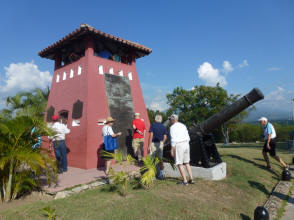We had lunch before our ship anchored off the city around 1:00 p.m. Shortly after, we went to the lounge for our 1:30 tour, Colonial
Santiago. We took a tender and arrived ashore just before 2:00. Already the weather was very
hot.

Model of Morro Castle |
A bus took us to the Morro Castle, several miles outside the city. There we had about 45
minutes to explore on our own. Because the Castle was built on such steep
terrain, it had a series of terraces, one above another, linked by a series of
stairways. In addition to the main Castle, there was a chain of smaller forts
and other defensive works running down the promontory, and many others behind
the Castle.
We entered at the top level over a small wooden bridge and
worked our way down. There were gun emplacements and a powder magazine at each
level, but also another feature at each level, such as a barracks or a command
building. Of couse, we had to climb back up all the stairways to get out of the
castle.

Approaching El Morro |

Bridge seen from inside |

Darrell on top level |

Stairs between levels |

Jane with small canon |

Gun platform & cistern |

Bridge & exterior wall |

Leaving the castle |
The next stop was at San Juan Hill, not too long a drive on the
circumvalacion (by-pass). The Hill was the site of a decisive battle during
the Spanish-American War (1898), in which future U.S. President Teddy Roosevelt
participated, leading his Rough Riders.,
We arrived about 3:30, and had less than half an hour to
explore on our own. Most of the original battlefield is now occupied by residential areas, a zoo,
an amusement park, a parkway and parking areas, but some of the crest of San Juan Hill
has been set
aside as a memorial park. There were multiple monuments, many canon, and a pink
replica of a blockhouse, but much smaller than those the Spanish had used.

Spanish blockhouse |

Battlefield today
|

Jane behind canon |

71st NY Vol. Inf. |
MONUMENTS TO

Spanish Soldiers |

Cuban Rebels (Mambis)
|
On the way back into the city center, our guide tried to get the passengers to agree to a stop for
shopping at a cigar and rum store, apparently motivated by the possibility of getting a cut of all
purchases (a common practice around the world)). However, she got only opposition and
abandoned the idea.

Santeria dancers
|
Not giving up on making a little extra money, she then began talking about Santeria, a mixture of
native African religions and Catholicism that is prevalent in the Carribean. This time, though, she
did not seek our approval. About 4:15 the bus suddenly stopped in a rough neighborhood, and we
were waved into a large hall in an old building. It was very hot and stuffy, cooled by a single fan.
Once we were inside, our guide announced that we were being treated to a Sentaria “ceremony,”
but it involved only dancers performing to the sound of extremely loud drums.
The performances consisted entirely of the dancers moving in a straight line
from the back of the hall to the front while violently shrugging their shoulders, staggering, twisting and
jumping. There seemed to be little "art" to it.

Looking for victim to sweat on |

Passing the basket |
The men were shirtless and dripping sweat. Some of them came
into the audience. One of them leaned over Jane for a good 30 seconds,
holding his face less than an inch away from hers while his sweat dripped
all over her. Then the female dancers came into the audience with baskets,
seeking donations. At that point I found that I had not brought
my wallet. (I did not carry it aboard the ship which had a “cashless” system.) One of the
women repeatedly insisted that I give her money, but I had no choice but to ignore her.
The
whole Santeria episode took about 40 minutes, but it was a very unpleasant experience. We
discovered later that ours was the only bus that made such a stop.
At 5:00 p.m. our bus arrived at Céspedes Park, Santiago’s first square and still the heart of the
city. The square is srrounded by famous buildings. To the south is the Cathedral
(Our Lady of the Assumption)(1526 but last rebuilt in 1932). To the west,
the Diego Velazquez House (1516-1530), the oldest surviving house in Cuba (and
probably in the western hemisphere). To the north, the City Hall
(Ajuntamento)(built in the 1950s from a 1783 plan). To
the west, the elegant Hotel Casa Grande (1914) and next door the San Carlos
Club (1912)(now the Casa de la Cultura).

Cathedral |

Diego Velazquez House |

City Hall |
Our guide provided no information whatsoever, not even when to be back at the bus. Luckily, the
two of us found restrooms in the Hotel Casa Grande. We also visited the Cathedral,
but only after a young man on the street corner helped us find
the very inconspicuous entrance (not on the square). We were the only visitors. We got back to
the bus about 5:30

S.Carlo Club & Casa Grande |

Jane at Velazquez House |

Inside the Cathedral |
Twenty minutes later we were at the tender dock. (Since he had forgotten his wallet, Darrell did
not have any money to tip our guide and driver.) There was a long line of passengers waiting to
take a tender back to the Sirena, but we were finally aboard about 6:30. We rushed to the lounge
for the daily lecture but missed the first ten minutes. This one was called The Jamaican Sugar
Roots of Elizabeth Barrett Browning. After dinner in the main dining room, we went to the 9:30
show in the lounge. It featured Broadway show music by the ship’s cast.
Page 1
2
3
4
5
6
7